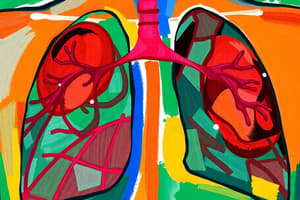Podcast
Questions and Answers
Most cases of bronchitis are caused by bacteria.
Most cases of bronchitis are caused by bacteria.
False (B)
Elderly people are listed as a high-risk group for chest infections.
Elderly people are listed as a high-risk group for chest infections.
True (A)
A persistent cough is not a common symptom of a chest infection.
A persistent cough is not a common symptom of a chest infection.
False (B)
Patients with chest infections usually recover within a year.
Patients with chest infections usually recover within a year.
Chest pain or tightness is among the symptoms of a basic chest infection.
Chest pain or tightness is among the symptoms of a basic chest infection.
Most patients with pneumonia should be encouraged to self treat by avoiding fluids to prevent dehydration.
Most patients with pneumonia should be encouraged to self treat by avoiding fluids to prevent dehydration.
Consolidation in pneumonia refers to the body's lung defenses successfully overcoming the infection.
Consolidation in pneumonia refers to the body's lung defenses successfully overcoming the infection.
In patients presenting with respiratory rates of 30 bpm, they are considered time critical and need immediate intervention.
In patients presenting with respiratory rates of 30 bpm, they are considered time critical and need immediate intervention.
Normal breath sounds include inspiration being shorter and quieter than expiration.
Normal breath sounds include inspiration being shorter and quieter than expiration.
Blood clots in pulmonary embolism most commonly form in the deep veins of the arm.
Blood clots in pulmonary embolism most commonly form in the deep veins of the arm.
Study Notes
Respiratory Conditions Overview
- Significant respiratory conditions to understand include basic chest infections, pneumonia, asthma, emphysema, bronchitis, pulmonary embolism, and respiratory distress.
Chest Infections
- Types include bronchitis (mostly viral) and pneumonia (mostly bacterial).
- Spread via coughing, sneezing, or contact with contaminated surfaces.
High-Risk Groups for Chest Infections
- Infants, elderly, overweight individuals, pregnant women, smokers, and those with chronic health conditions.
- Weakened immune systems (due to recent illnesses, chemotherapy, or undiagnosed conditions) increase risk.
Basic Chest Infection Symptoms
- Persistent cough with yellow/green phlegm or blood.
- Breathlessness, rapid/shallow breathing, wheezing, fever, rapid heartbeat, chest pain, and confusion.
Management of Basic Chest Infection
- Generally self-treatable, with recovery expected within days to weeks.
- Recommend rest, hydration, and over-the-counter painkillers (e.g., paracetamol, ibuprofen).
Pneumonia Pathophysiology
- Inhalation of bacteria/viruses causes inflammation; if not resolved, fluid buildup (consolidation) occurs in the lungs.
Clinical Features of Pneumonia
- Signs: fever, productive cough, increased respiratory rate, bronchial sounds upon auscultation, and chest pain.
- Symptoms: high temperature, tachycardia, and muscle/joint pain.
Management of Pneumonia
- Time-critical if patient exhibits significant breathing issues; prompt hospital alert required.
- Oxygen therapy aimed at 94-98% SpO2 and the patient positioned for comfort. Monitor vital signs.
Pulmonary Embolism (PE) Pathophysiology
- Clots typically form in deep veins (calf), travel up, and can obstruct pulmonary arteries, causing respiratory distress.
PE Clinical Features
- Signs and symptoms include dyspnoea, tachypnoea, cough with blood, syncope, and a history of prolonged immobility or risk factors (e.g., obesity).
Management of Pulmonary Embolism
- Immediate evaluation for severe symptoms (extreme breathlessness, cyanosis).
- Consider oxygen therapy, monitoring vitals, and pre-alerting emergency services.
Bronchitis
- Inflammatory condition impacting airways; acute forms caused by infections and chronic forms from long-term damage.
- Symptoms include productive cough, dyspnoea, cyanosis, elevated heart rate, and abnormal breath sounds.
Emphysema Overview
- Characterized by loss of alveolar elasticity and airway collapse, often resulting in a barrel-shaped chest.
- Common symptoms include pursed lip breathing, weight loss, confusion, and increased blood pressure.
Asthma Overview
- A prevalent condition that can escalate quickly into life-threatening scenarios; monitoring is crucial.
- Incidences can be classified into moderate, severe, life-threatening, and near-fatal.
Asthma Pathophysiology and Triggers
- Airways remain inflamed and sensitive, with triggers such as pollen, smoke, dust, pets, and exercise.
- Patients encouraged to identify and manage their specific asthma triggers.
Asthma Exacerbation Classifications
- Moderate: patient can talk in sentences, stable vitals.
- Severe: difficulty with sentences, respiratory rate increased, possible cyanosis.
- Life-threatening: silent chest, exhaustion, low oxygen saturation, requiring immediate intervention.
Management of Severe Asthma
- High-flow oxygen administration and immediate nebulized treatments.
- Quick triage and assessment necessary to deliver timely care, with minimal on-scene time.
Peak Flow Measurement
- Key in monitoring asthma: involves five steps to ensure accuracy when blowing into the device, measuring lung function effectively.
Studying That Suits You
Use AI to generate personalized quizzes and flashcards to suit your learning preferences.
Description
This quiz covers significant respiratory conditions, focusing on chest infections like bronchitis and pneumonia. You'll learn about high-risk groups, symptoms, and management strategies for basic chest infections, promoting better understanding and awareness. Test your knowledge on the vital aspects of respiratory health.




